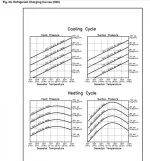oscarvan
Legendary Member
- Joined
- Oct 31, 2015
- Messages
- 2,926
- Status
- OTHER
- Hatteras Model
- Not Currently A Hatteras Owner
Two heat pumps are kicking butt. The other two are working but not as they should. Suction side on the former is hot, on the latter is tepid. On the latter what I believe to be the dryer (soup can sized container next to the compressor) is icing slightly.
My limited experience says they're a little low on refrigerant.
Can someone confirm they run on R-22?
And, is there a pressure chart for these anywhere?
I could use the Delta-T method and add small amounts until the output temp matches the good ones, but I'm hesitant to do that because if low refrigerant is NOT the cause it's not good for them. I can also hook up the gauges to the good ones and read them and then hook up to the lazy ones and see what I get.....
Thoughts? (Other than "Call a professional")
Thanks.
My limited experience says they're a little low on refrigerant.
Can someone confirm they run on R-22?
And, is there a pressure chart for these anywhere?
I could use the Delta-T method and add small amounts until the output temp matches the good ones, but I'm hesitant to do that because if low refrigerant is NOT the cause it's not good for them. I can also hook up the gauges to the good ones and read them and then hook up to the lazy ones and see what I get.....
Thoughts? (Other than "Call a professional")
Thanks.


